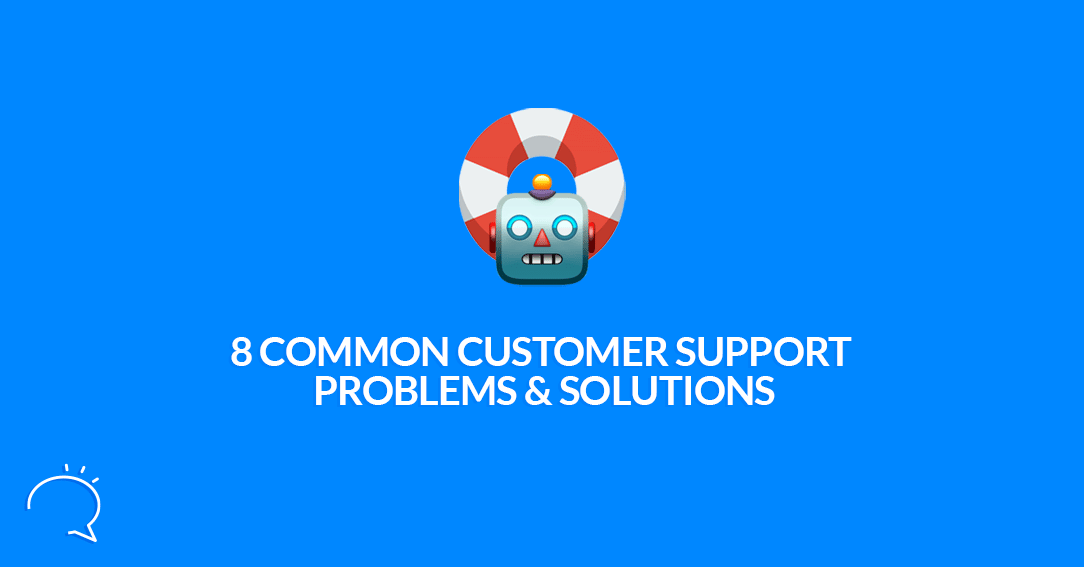Those who work in customer service often say helping a customer with their support problems sometimes feels like solving a puzzle. A puzzle that’s sometimes is solved fast, and, sometimes slow. Slow because sometimes pieces just don’t fit, or pieces just seem to be missing. These pieces I’m talking about obviously reflect the problems in a customer support desk. And yes, while every ticket is different, a customer support desk and their agents should run efficiently. Because, in the end, it’s all about the customer, and as a customer service agent you should always find the proper resolution to the customer’s problem… and so solving the puzzle.
The question is that at the end of the day, what does your customer service puzzle look like? Can you lay out the whole image? Or is it more of a chaotic one? Let’s dig in! In this article, we are taking a look at the 8 most common customer support problems – and their resolutions.
8 Common Customer Support Problems & How to Resolve Them
1. It May Seem It Takes Too Much Time to Resolve the Issue
It is both a problem for the customer and the customer representative; the time it takes to resolve the issue. There can be many reasons why this happens. It could be that it needs difficult troubleshooting to resolve the issue. The representative may need to call in the help of a developer or IT specialist to fix a bug. Or, they might need to chat with a third party’s upper hand to see why something is not working. It could also be, communication with the team is necessary to end the dilemma.
How to resolve: Show your customer that you care. Many customers appreciate getting updates, even if the real answer is still far away. By updating them regularly about the current status of the ticket, you show that you’ve not forg0tten about them. What’s cool is that chatbot on Messenger can be used to automate this as well. The chatbot can, by being integrated into the support desk, check the status of the ticket and send a follow-up every 24 hours about the status of their ticket.
2. The Agent Is Not Hearing The Customer’s Needs
Listening skills are a real asset went comes to being a customer service agent. But really hearing your customer is something else. People want to hear and understood, especially when they are frustrated with a product or service they bought from you. The customer service agent may come in all prepared. But, without the ability to emphasize with a customer when s/he clear needs it, it will all be in vain.
How to resolve: Ensure that you, as customer agent, have understood the customer’s issue. Double-check the problem. Don’t be afraid to ask twice if you don’t understand it correctly the first time. They may also follow up with a sincere apology. Admit the fault to the customer if it’s really the fault of a company. Take responsibility. And, when the solution is ready, share it with the customers right away and tell them you’re going to do a better job next time something surfaces.
3. Missing Policies
We won’t get too wordy on this problem. There are instances when the customer support agent is not aware of policies. Team leaders and company leaders should be held responsible for that. Any changes to policies should be communicated throughout the team so everyone is in the know. This, of course, can also happen with automated responses delivered by a chatbot. If a policy changes, and your chatbot is saying something that was still okay with the old policy, it obviously needs to be updated.
How to resolve: Do monthly policy checks and see if everyone in the team is on the same page. If something changed, check your SOPs and see if they’re affected or not, if so, change them!
4. There Are No Humans Answering The Phone, or Long Waits.
Customer service support calls don’t really work. Sometimes you call a number you find out there is no agent at all, but just some lame IVR that you need to go through. The latter can be done by a chatbot just fine, and usually better and faster too. Because not only are these IVR systems outdated, using old speech recognition software that has a lot of trouble understanding accents. It just takes very long to get through an automated menu. While a chatbot is faster and also visualizes the entire process.
That said, in earlier articles here on Clepher, we mentioned it a couple of times already, people prefer to chat over calling. So why some companies don’t take the hint already is beyond me. Plus, when a company is offering phone support, they need to be sure as hell not to let anyone wait for too long. Frankly, any wait time over 1.30 minutes is just way too much.
How to resolve: Automating customer service with a chatbot is the #1 solution. More than half of people having an issue with a product or service prefer to chat over calling anyway, so make use of that stat by implementing a chatbot.
5. Customer Is Transferred To Another Agent Over and Over
If you’ve ever gone through Adobe’s or Facebook’s chat support you know what I mean… It’s just a long maze and without any speedy resolutions. Which I think is just strange, being the billion-dollar companies they are. Yup more often than now, the customer speaks to a customer support agent, the agent holds the conversation for a few seconds. Then returns, only to mention you’re being transferred to another department or specialist. This can happen once, but once it happens twice or more, it will surely irritate the client.
How to resolve: A chatbot can help. Instead of qualifying a lead, qualify the support question! Funnel the person to the right department before they actually can ask their question. This will save a lot of transferring drama in the long run. A chatbot can simply provide the departments of the support desk, then once a customer clicks on the department, the bot can provide common support questions and their answers. If the customer is still in need of help, the chatbot can ask for more specifics from the customer and use that data to provide the right resolution or call a human.
6. Being Rude As a Customer Service Agents to Customers
Not listening to, or not hearing, what the customer is saying is worse in itself. But, as a business, you should hire a team of representatives with the right attitude. If they’re rude, you probably did not hire the right person for the job. Yet, customers can be really nasty sometimes, which can make a human support agent flip, they’re human after all.
How to resolve: A chatbot doesn’t have this problem, it doesn’t feel any emotion, so a customer can go all out to a chatbot, vent their frustration, while it’s still trying to help them out. Plus, you’d have to program a chatbot to be rude for it to act rude. There’s no way a chatbot will ever be rude to customers if it’s not programmed to do so.
7. Having no Follow-Through
Updates and follow-throughs are two different things. The former may be updating them with factual information. The latter, follow-through, is assurance. For example, telling a customer that you, as a support agent, will connect with the customer the next day. As the customer sees this promise being fulfilled it will build trust. However, if it’s just an empty promise, it will damage the relationship and will make the customer frustrated. And can you blame the customer? The support agent could not even fulfill the promise of a simple follow-up message… The customer now thinks the agent is incapable.
How to resolve: The customer service team should follow-up based on their promises. By using the right CRM, or managing these promises in a simple sheet, an agent can easily follow the list and follow-up with the customers that were promised a response.
8. The Customer is Stuck With Your Chatbot
A customer is in search of help, they have been chatting with a chatbot, only to find out the bot’s response is not enough. The customer is now stuck and doesn’t know what to do next.
How to resolve: First, when you use a chatbot in your business, it is vital to make sure they have the correct details. This way the bot can help customers out just fine. And, documentation is crucial, use the chatbot to refer to articles and videos in a knowledgebase, instead of having the chatbot trying to solve the issue in the chat. Then finally, always offer a way out, meaning a button to Connect to a Human, this way the customer can always request a human agent to step in.
The Importance of Great Customer Support
One of the best advantages of improved customer support is increasing sales. Offering a great product is one thing. Yet, having good customer service also plays a huge role. Customer loyalty and customer service go hand-in-hand together. The most obvious benefit is obviously that it can provide a business with repeat customers. It generates good reviews, but it can also gain referrals due to existing customers voicing their opinion about your heroic support desk to their peers. And finally, people will gladly pay more for your products once it comes with excellent customer service.
Improving your Products
Customer service also is the perfect opportunity for you to get feedback on your products or services. Good or bad, it will help improve whatever it is you’re selling. It also takes customer loyalty further. Good feedback is, most of the time, flattering – and can be used as testimonials. But, while bad customer feedback may be harmful, this is the type of feedback you want because it will help your business to create better products.
New customers
The best customer service opens possibilities! See, when you have repeat customers, you can create a loyalty program. For instance, you can give out freebies to customers who are celebrating their birthdays. You can let them know how you notice they buy your product often. Tell them you want to celebrate with them on their special day by giving them a gift. Then, your customer, and quite possibly their friends, remember how the company gave them a present. When done right, it can likewise promote the company and its products. People will not buy your offer if they are not aware of your presence. Whether you see it, or not (yet), customer service is a great way to widen your reach.
Conclusion
Customer support can have its problems, but as you can see, the solutions aren’t that hard. And by fixing your customer support problems you open up many more opportunities for your business. Whether it’s generating feedback to make your product better, or having a steller support desk that inspires people to talk more about your brand… A support desk that runs without any issues is another important cog in the wheel of your business.
That said, you have learned about the 8 most common customer support desk problems, and you’ve also read that most of your customer support issues can be solved by a chatbot. Clepher just so happens to be a Chatbot Creator that can help you with your issues. Check us out today!
Related Posts



